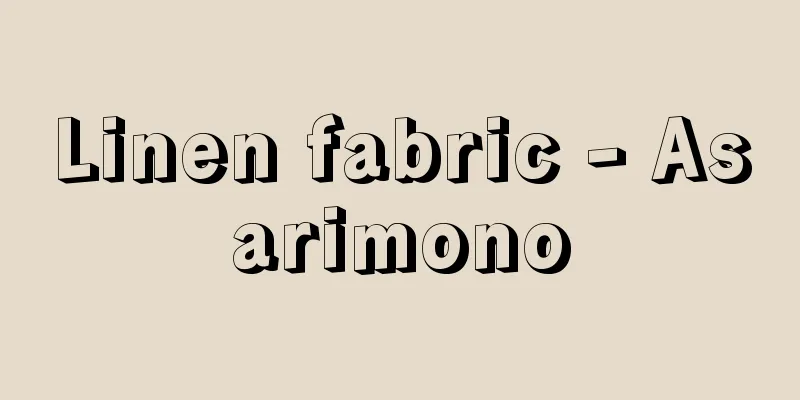Linen fabric - Asarimono

|
Hemp is a general term for flax (flax, linen), taiman (hemp), choma (ramie, a variant of ramie), and kouma (jute), and fabrics made by spinning and weaving these grass bark fibers are called hemp fabrics. In Japan, it is also called asabu or cloth, and can refer to fabrics made from bark fibers of trees such as wisteria and kozo. Originally, taiman and choma were the main fibers, but after the Meiji period, flax and kouma were introduced, resulting in a wide variety of fibers. These fibers are semi-long fibers that can be spun relatively long, and therefore have been used for clothing since prehistoric times. In the premodern spinning method, the hemp was pulled from hemp fields in the summer, soaked in water, dried to separate the fibers, beaten, and then torn into thin fibers with the toes of the fingernails. The hemp tails and heads were twisted together to make a continuous string, which was then hung in a hemp basket. The size of the basket was also an indication of the amount of work, and was related to the total amount of thread in one bolt of cloth. Finally, holes were drilled in a flat disk, and the thread was twisted with a spindle with a rod attached to it to make thread. Spindle wheels made of clay, wood, and bone have been excavated from Yayoi period ruins, indicating the origins of spinning from this period. In the Middle Ages, the twisting process was sometimes omitted, but in the early modern period, spinning wheels used for cotton were also used for hemp spinning, improving production efficiency. However, fine yarn was not twisted and was woven as is, resulting in a glossy and flexible fabric. During the Yayoi period, weaving was done on primitive looms (genshibata), but later on local looms came into use, and in some areas this was replaced by takabata looms. Globally, linen textiles appeared earlier than other textiles; fragments of linen dating back to around 5000 BC were discovered in the Fayoum ruins in Egypt, and the remains of lake dwellings in Switzerland are famous for having unearthed a large amount of linen textiles. In Japan, seeds of the taima plant were excavated from the Sugo ruins in Chiba Prefecture, which dates back to the late Jomon period, suggesting the presence of fibrous plants, and in the Yayoi period, fragments of choma textiles were excavated from the Ayaragi ruins in Yamaguchi Prefecture and other sites, and traces of fabric grain remain on the bottoms of pottery excavated in various places. In the Kofun period, some were found attached to metal products excavated from tumuli, and it is clear that the quality was divided into good and bad products and that they were used for various purposes. In the Nara period, with the development of silk textiles, linen became common as clothing for the common people. Choyo hemp cloth was paid as tax from various regions, and the eastern part of Japan (the Kanto region) was a speciality area, with famous products such as Kazusa Hosofu and Hitachi Sarashinuno. Choyo cloth from this period remains in the Shosoin Repository, and most of it is made of Choma cloth of various qualities, with coloring and surimon (patterned patterns). When the Choyo system declined, hemp cloth production continued in areas suitable for cultivation. In the Middle Ages, Shinano Province (Nagano Prefecture) and Echigo Province (Niigata Prefecture) were well known, and even monopolies such as Echigo Aoza and Nunoza appeared. In the early modern period, it was respected as one of the three herbs, and local specialty products such as Uji Sarashi, Nara Sarashi, Echigo Jofu, Omi Takamiyafu, and Omi Kaya were born in each region. As hemp was the formal material for samurai kamishimo, there was a certain demand for it and the quality improved. Echigo Jofu in particular was made with thin threads, and it was so thin that it could be squeezed through the holes in a Tenpo coin, making it a high-quality product. Yuki-sarashi can be bleached many times without damaging the fibers, and is still practiced today, becoming a feature of snow country. Since the mid-Meiji period, hemp has been overwhelmed by cotton and the area of land where it is cultivated has rapidly decreased, but recently processing methods have been devised that take advantage of its characteristics, and production has continued on a small scale. In modern hemp weaving, the hemp fibers vary in hardness and softness depending on the type, so they are pretreated by boiling or soaking depending on the fiber, and the fibers are drawn. After that, they are spun using two methods: line spinning, which uses long fibers as they are, or tow spinning, which uses short fibers cut to an appropriate length. In addition, a wet spinning process, in which the fibers are soaked in hot water, may be added to make them easier to spin. Power looms are commonly used for weaving, but additional equipment is added depending on the characteristics of the fiber. Linen fabrics are mostly plain weave, with twill and satin weaves being seen only in rare cases. In terms of uses, it is rarely used in the field of clothing, and was rather used as a material due to its strength and water resistance. Furthermore, the development of synthetic fibers produced fabrics with properties similar to that of linen, accelerating the decline in the use of linen fabrics. However, blending and interweaving with polyester has produced optimal fabrics, and in order to prevent linen's drawback of being prone to wrinkling, resin processing has been applied and the quality has been improved. As linen fibers have a low affinity for dyes, dyeing is difficult, so white fabrics are the most common, and although some thread dyeing such as kasuri is used, there are very few textile prints. Bleaching is done lightly with chlorine (bleaching powder), but as the fibers are easily damaged, sun-bleaching is still used. The fabric is highly absorbent, quickly wicks away moisture, and is prized for its smooth feel, making it suitable for summer kimono fabrics, and well-known varieties include Echigo Jofu (Ojiya Chijimi), Satsuma Jofu, Noto Jofu, and Yaeyama Jofu. Wide-width items are often used for shirt fabric, but most are blended with synthetic fibers, and traditional uses include tablecloths, napkins, handkerchiefs, and interlining for clothing. Thick items are used for canvas, rain covers, hoses, etc., and jute fabric is mainly used as packaging material due to its quality. [Kadoyama Yukihiro] FolkloreIn Japan, hemp was widely used as a material for clothing among ordinary people. Silk was also used by the upper classes, but silk, due to its quality, was not suitable for clothing for workers. There are various theories about when cotton was introduced to Japan, but it is thought to have been in the early Edo period, and it gradually spread to various parts of the country. Until then, most people in Japan wore hemp fabrics, and people in the cold regions of the Tohoku region, where cotton cannot be cultivated, used hemp cloth until the Meiji period. Therefore, in this region, "ito" means hemp thread, cotton thread is called "kana," and hemp cloth is called "nuno" or "nono." As can be seen in the song "When I wear hemp, I feel nostalgic. I sow hemp in the mountains of Imose in Ki Province. My younger sister (Wagimo)" (Manyoshu, Volume 7), which is a song about a husband who thinks of his wife working hard to sow hemp in the fields to make clothes for the family, every time he puts on hemp clothes. The hemp fields were left entirely under the management of the housewives, and all the work from pulling out the hemp, drying it, steaming or boiling it, soaking it in water, and extracting the fibers was done by hand by women. Furthermore, splitting the fibers into thin strips and spinning them into thread was mostly a job that required night shifts. The women in the household were assigned some hemp by the housewives, and they would spin it and turn it into thread that could be put on the loom, but it was painstaking and tedious work. The line in a temari song, "The loom is set in 13...", was probably true. In the Tohoku region, kimono shops were called "momen-ya", and this shows how valuable momen was in this region, and that everyday clothing was linen fabric called nuno. [Hisako Maruyama] Important Intangible Cultural Property Ojiya City, Niigata Prefecture ©Shogakukan "> Echigo Jofu (woven pattern) Source: Shogakukan Encyclopedia Nipponica About Encyclopedia Nipponica Information | Legend |
|
アサは、アマ(亜麻、リネン)、タイマ(大麻)、チョマ(苧麻、一名カラムシ。変種はラミー)、コウマ(黄麻、ジュート)などの総称で、これらの草皮繊維を紡いで織ったものを麻織物という。日本では麻布または布ともいい、フジ、コウゾなどの樹皮繊維からなる織物を含めてさすことがある。もとタイマ、チョマが主要な繊維で、明治以後アマ、コウマが移入され、繊維の種類は豊富となった。 これらの繊維は、準長繊維として比較的長く績(う)みやすいので、原始時代から衣料として使われた。前近代の紡績法は、夏にアサ畑から引き抜き、水に浸してから乾燥して繊維分離をよくし、麻打ちしたのち爪先で細く繊維を裂き、麻尾と麻頭を撚(よ)りつないで連続した状態とし、麻笥(おけ)に垂らし収めた。麻笥の大きさは作業量の目安ともなり、一反の総糸量とも関係していた。最後に平たい円盤に穴をあけ、棒をつけた紡錘(つむ)で撚りをかけ、糸とした。弥生(やよい)期の遺跡から、土、木、骨製の紡錘車が出土し、この時期からの紡績始原を示している。中世には撚りかけを省略することもあったが、近世には木綿に使う糸車を麻紡績にも使い、生産能率を向上させたが、上質糸では撚りをかけず、そのまま織物としたので、光沢に富み柔軟性に富んでいた。製織は弥生時代には原始機(げんしばた)によったが、のち地機が使われ、一部の地域では高機(たかばた)にかわった所もある。 世界的にみても麻織物の出現は、ほかの織物に比べて早く、エジプトでは紀元前5000年ごろの亜麻布の断片がファイユーム遺跡で発見されているし、スイス湖上住居跡は多量の麻織物を出土したことで有名である。日本では、縄文晩期の千葉県菅生(すごう)遺跡からタイマの種子が出土し、繊維植物の存在が推測され、弥生時代になると、チョマの織物片が山口県綾羅木(あやらぎ)遺跡などから出土し、また各地出土の土器底部に布目が痕跡(こんせき)として残っている。古墳時代では古墳出土の金属製品に付着するものがあるが、品質は粗悪なものと良質なものとに分けられ、適当な用途にあてられていたのがわかる。奈良時代になると、絹織物の発達により麻布は庶民の衣料として一般化した。税として調庸(ちょうよう)の麻布が各地から貢納されたが、そのうち東国(関東地方)が特産地で、上総(かずさ)細布、常陸(ひたち)曝布(さらしぬの)などが著名であった。正倉院にはこの時期の調庸布が残されているが、多くはチョマで各種の品質にわたり、彩色、摺文(すりもん)などが施されている。この調庸制が衰退すると、栽培適地で麻布生産が続けられた。 中世では、信濃(しなの)国(長野県)、越後(えちご)国(新潟県)が知られ、越後青苧座(あおざ)、布座(ぬのざ)などの独占業者まで出現した。近世では、三草の一つとして尊重され、宇治晒(うじさらし)、奈良晒、越後上布(じょうふ)、近江(おうみ)高宮布(たかみやふ)、近江蚊帳(かや)など各地に特産品が生まれた。武家の裃(かみしも)は麻が正装であるため、一定の需要が保たれ品質も向上した。とくに越後上布は糸が細く薄地で、しごいて天保銭(てんぽうせん)の穴に通るほど薄地で上質な品までつくられた。雪晒は繊維が損傷せず幾回もさらせるため、現在も続けられ雪国の風物とさえなっている。明治中期以後は木綿に圧倒されて、アサの栽培面積は急激に減少したが、最近では特性をいかした加工処理が考案され、わずかに生産が続けられている。 近代麻紡織は、麻繊維の種類により硬軟があるため、繊維により煮沸、浸漬(しんせき)などの前処理をし、繊維を採線にしたのち、長い繊維については、そのままの長線を用いるライン紡績、または適当な長さに切断し短繊維にしたものを用いるトウ紡績の2系統により紡績される。さらに、繊維を紡績しやすくするため湯浸(とうしん)する潤紡が加えられることがある。製織は力織機(りきしょっき)が一般化したが、繊維の特性に応じた装置が加えられている。 麻織物の組織は平織が多く、綾(あや)、朱子(しゅす)組織はわずかしかみられない。用途からみると、衣料の分野には少なく、むしろ強度、耐水性のあることから資材用として使われた。それに合繊の発達が麻の特性に近いものを生み出し、麻織物利用の減少に拍車をかけた。しかしポリエステルとの混紡、交織により最適の生地を生み、また麻の欠点であるしわになりやすいことを防ぐため、樹脂加工が施され、品質の改良が行われている。染色加工は、麻繊維は染料との親和力が小さいため染色が困難なので、白生地のものがもっとも多く、一部に絣(かすり)などの糸染めがあるが、捺染(なっせん)するものはきわめて少ない。漂白は軽くカルキ(さらし粉)漂白を行うが、繊維が冒されやすいので、天日晒しもいまだに使われている。 生地は、水分の吸収性に富み、発散が早く、さらさらした肌触りが珍重されるので、夏の着尺地(きじゃくじ)に適し、越後上布(小千谷縮(おぢやちぢみ))、薩摩(さつま)上布、能登(のと)上布、八重山(やえやま)上布などが知られている。広幅物ではシャツ地に使用されることが多いが、ほとんどが合繊混紡となり、伝統的な用途にテーブルクロス、ナプキン、ハンカチーフ、洋服芯地(しんじ)などがある。厚地のものは、帆布(はんぷ)類、雨覆い、ホースなどに使われ、そのうち黄麻織物は、品質のうえからおもに包装材料に用いられる。 [角山幸洋] 民俗わが国の衣料の原料として一般庶民の間に広く使われていたのは麻であった。上流社会では絹も使われていたが、絹は、布質からいっても労働をする者の衣料としては使えるものではなかった。木綿がわが国に入ってきた時期については諸説があるが、江戸初期と思われ、それからだんだん各地に普及していくわけであるが、それまでわが国の大部分の人は麻織物を着ていたわけで、とくに木綿の栽培ができない東北地方の寒冷地の人々は、明治期まで麻布を用いていた。したがってこの地方では、イトというのは麻糸のことで、木綿糸はカナといい、麻布をヌノとかノノなどとよぶ。麻衣きればなつかし紀の国の妹背(いもせ)の山に麻まく吾妹(わぎも) (『万葉集』巻7)という歌にもうかがわれるように、麻を畑にまいて家族の着物のためにせっせと働いている妻を、麻衣を着るたびに思い浮かべている夫の歌である。 麻畑はもっぱら主婦の管理にゆだねられ、麻の引き抜き、乾燥、それを蒸すか茹(ゆ)でるかして水にさらし、繊維を取り出すまでの作業はすべて女の手仕事となっていた。さらにこの繊維を細く裂いて糸に績(う)むことは、おおかた夜なべ仕事であった。家の女たちは、主婦からいくばくかの麻が割り当てられ、それを績み、機(はた)にかけられるような糸に仕上げたが、根気のいる退屈な仕事であった。手まり唄(うた)にある「十三で機を織りそめ……」という文句も、事実であったろう。東北地方では呉服屋のことをモメンヤとよんでいたが、この地方ではモメンがいかに貴重品であり、平常着はヌノといわれる麻織物であったということを物語っている。 [丸山久子] 重要無形文化財 新潟県小千谷市©Shogakukan"> 越後上布(織紋) 出典 小学館 日本大百科全書(ニッポニカ)日本大百科全書(ニッポニカ)について 情報 | 凡例 |
Recommend
Aestheticism
Aestheticism is a worldview or outlook on life tha...
Cherry blossom viewing in the tenement house
Rakugo. The Kamigata rakugo "Binbou Hanami&q...
Enshu Tanba
…Specialty products of the region include the Asa...
Kirishima Shrine
Located in Kirishima Taguchi, Kirishima City, Kag...
Chord length
Aerodynamics is the process by which the airfoil ...
produit net (English) produitnet
...The advocacy of laissez-faire was based on the...
'Ali bin al-'Abbās
?-994 A medieval Iranian physician. His Latin name...
airport surface detecting equipment
…ILS, in combination with on-board equipment, can...
Memorial service - Kisaishi
...The relationship between large and small famil...
Saxifraga cortusaefolia (English spelling) Saxifragacortusaefolia
… [Michio Wakabayashi]. … *Some of the terminolog...
Nasser
Egyptian soldier and politician. He participated i...
Saburo Ogata
...The name was probably chosen because the hair ...
Disaster film
...From the 1960s to the 1970s, the interest of y...
Sant'Apollinare Nuovo (English spelling)
...The mosaics of the Arian Baptistery were made ...
Porto‐Novo (English spelling)
The capital of the Republic of Benin, facing the G...









